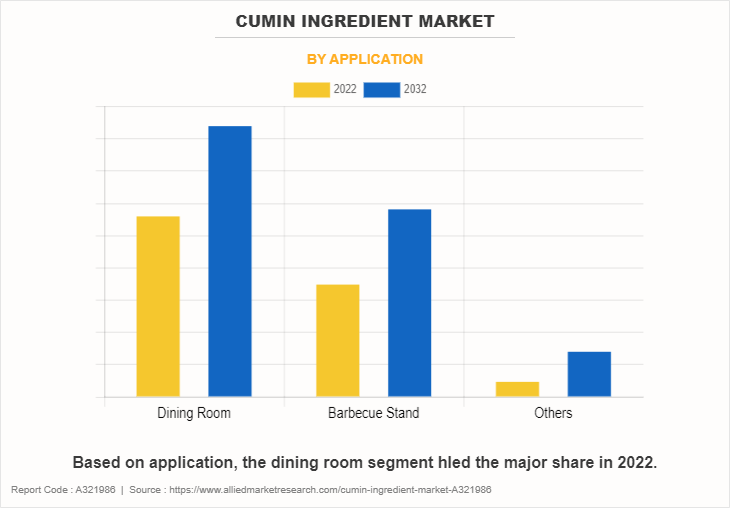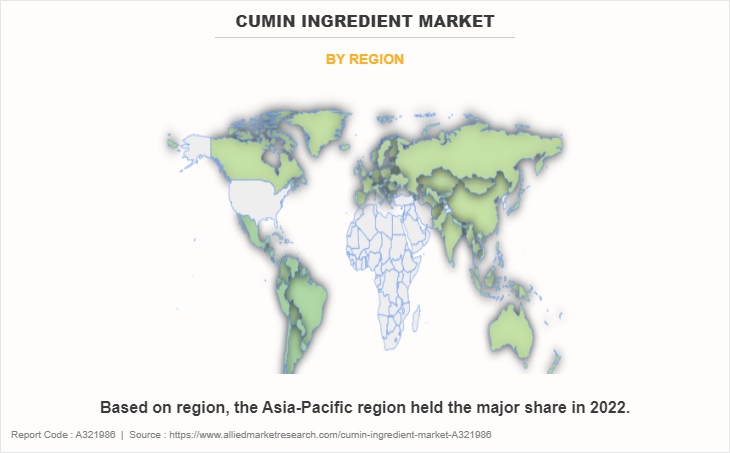Cumin Ingredient Market Research, 2032
The global cumin ingredient market size was valued at $1.3 billion in 2022, and is projected to reach $1.9 billion by 2032, growing at a CAGR of 4.1% from 2023 to 2032. Cumin is a spice derived from the seeds of the Cuminum cyminum plant, widely used in culinary applications worldwide. It possesses a warm, earthy flavor with a hint of citrus and is a staple in many cuisines, including Indian, Mexican, Middle Eastern, and North African. Cumin adds depth and complexity to dishes such as curries, stews, soups, and rice. It is also a key component in spice blends like garam masala and taco seasoning. Beyond its culinary uses, cumin is believed to have potential health benefits, including aiding digestion and possessing antioxidant properties.

Key Takeaways of Cumin Ingredient Market Report
- By Type, the powder segment was the highest revenue contributor to the Cumin Ingredient Industry in 2022, and is expected to grow at a significant CAGR during the forecast period.
- By application, the barbecue stands segment was the highest revenue contributor to the market in 2022, and is expected to grow at a significant CAGR during the forecast period.
- By Region, the North America region was the highest revenue contributor to the market in 2022, and is expected to grow at a significant CAGR during the forecast period.
Market Dynamics
Growing consumer demand significantly surges the market demand for cumin as an ingredient in various culinary applications. As consumer palates become more sophisticated and adventurous, there is a heightened interest in exploring diverse cuisines and flavors worldwide. Cumin, with its distinctive earthy and aromatic profile, is increasingly sought after to add depth and complexity to a wide range of dishes, spanning from Indian curries to Mexican salsas and Middle Eastern rice pilafs. Moreover, as awareness of the health benefits associated with cumin grows, including its potential digestive aid properties and antioxidant content, consumers are integrating it more prominently into their diets. This health-conscious trend further fuels the demand for cumin, as consumers actively seek natural ingredients with perceived functional benefits. Consequently, the surge in consumer demand drives the cumin ingredient market growth, encourages innovation in product development, and expands its presence across various segments of the food industry, including packaged food, restaurants, and home cooking.
Additionally, the rising popularity of ethnic food significantly surges the market demand for the cumin ingredient. As consumers increasingly explore diverse culinary traditions, particularly from regions such as India, the Middle East, and Latin America, they encounter cumin as a ubiquitous spice in these cuisines. This exposure fosters a greater appreciation for cumin's unique flavor profile and versatility in enhancing dishes, leading to heightened demand across various food sectors. Moreover, the growing trend of globalization has facilitated the spread of ethnic cuisines to new regions, further driving the demand for cumin. As restaurants and food manufacturers cater to the evolving tastes of multicultural societies, they incorporate cumin into a wide array of products, from spice blends and sauces to ready-to-eat meals. This expansion of cumin's usage beyond traditional culinary boundaries amplifies its market demand, making it an essential ingredient in the global gastronomic landscape. Overall, the increasing popularity of ethnic food catalyzes the burgeoning demand for cumin, propelling its market growth across diverse culinary traditions.
Furthermore, health awareness has significantly surged the market demand for cumin as an ingredient due to its perceived health benefits. Cumin is increasingly recognized for its digestive properties, as it contains compounds that may aid in digestion and alleviate gastrointestinal discomfort. This makes it particularly appealing to health-conscious consumers seeking natural remedies and functional food to support their overall well-being. As people become more mindful of their diets and seek out ingredients with nutritional value, cumin stands out for its potential to enhance both the flavor and health profile of dishes. Furthermore, the antioxidant properties of cumin have garnered attention among consumers looking to incorporate more antioxidants into their diets to combat oxidative stress and promote cellular health. As a result, the rising demand for cumin in various culinary applications is driven not only by its distinct flavor but also by its perceived health-promoting properties. This increased awareness of cumin's potential health benefits has led to its incorporation into a wide range of food products, driving the cumin ingredient market demand.
In addition, the expanding food industry plays a pivotal role in surging market demand for the cumin ingredient. As the food industry grows, particularly in sectors such as processed food, restaurant chains, and ready-to-eat meals, there is an increasing need for flavorful and versatile ingredients like cumin. Food manufacturers and chefs alike recognize cumin's ability to enhance the taste profiles of a wide range of dishes, from soups and stews to snacks and condiments. It is warm, earthy flavor adds depth and complexity, appealing to consumers seeking diverse culinary experiences. Moreover, the expanding food industry drives innovation and experimentation in product development, leading to the creation of new cumin-infused food products and menu items. This diversification not only caters to changing consumer preferences but also expands the reach of cumin into new markets and consumer segments. As a result, the demand for cumin as an essential ingredient in the food industry continues to grow, driven by the industry's quest for unique flavors, culinary creativity, and consumer satisfaction.
Segmental Overview
The cumin ingredient market is segmented into type, application, and region. By type, the market is segmented into oil and powder. By application, the market is segmented into dining rooms, barbecue stands, and others. By region, the market is analyzed across North America, Europe, Asia-Pacific, LA, and MEA.
By Type
By type, the market is segmented into oil and powder. The oil segment accounted for a major Cumin Ingredient Market Sharein 2022 and is expected to grow at a significant CAGR during the forecast period. The rising demand for oil in the cumin ingredient market can be attributed primarily to its versatility and nutritional value. Cumin oil serves as a key component in various culinary applications, including cooking, seasoning, and flavoring. Moreover, it possesses numerous health benefits, such as aiding digestion, boosting immunity, and promoting skin health, which has further fueled its popularity. Additionally, the growing awareness regarding the therapeutic properties of cumin oil, including its anti-inflammatory and antioxidant properties, has contributed to its increasing demand across the food and healthcare sectors.

By Application
By application, the market is segmented into dining rooms, barbecue stands, and others. The barbecue stand segment accounted for a major market share in 2022 and is expected to grow at a significant CAGR during the forecast period. The barbecue stand segment holds a major share in the cumin ingredient market due to several factors as barbecue stands are gaining popularity as convenient and casual dining options, leading to increased foot traffic and sales opportunities. Secondly, cumin's versatile flavor profile makes it a sought-after ingredient for creating rich and savory barbecue sauces, rubs, and marinades, enhancing the taste of grilled meats and vegetables. Additionally, growing consumer interest in global cuisines and bold flavors has spurred the exploration of cumin-infused barbecue dishes, further fueling demand in this market segment.

By Region
By region, the market is analyzed across North America, Europe, Asia-Pacific, LA, and MEA. North America held the major market share in 2022 and is expected to grow at a significant CAGR during the forecast period. North America holds a major share in the cumin ingredient market due to several reasons. Firstly, cumin is widely used in Mexican and Tex-Mex cuisines, which are highly popular in the region. Secondly, the growing trend of ethnic food and diverse culinary preferences among North American consumers drives the demand for cumin. Additionally, the presence of a well-established food industry, including processed food and restaurant chains, further contributes to the market share. These factors combined make North America a significant consumer and importer of cumin globally.

Competitive Analysis
The major players operating in the market focus on key market strategies, such as mergers, product launches, acquisitions, collaborations, and partnerships. They have been also focusing on strengthening their market reach to maintain their goodwill in the ever-competitive market. Some of the key players in the global cumin ingredient industry include Starwest Botanicals, McCormick & Company, Young Living Essential Oils, TERRA, Madagascar Spices Company, Phoenix Herb Company, AOS Product, Essential Oils Company, AASHVI CORPORATION.
Key Benefits for Stakeholders
- This report provides a quantitative analysis of the market segments, current trends, estimations, and dynamics of the cumin ingredient market analysis from 2022 to 2032 to identify the prevailing cumin ingredient market opportunities.
- The market research is offered along with information related to key drivers, restraints, and opportunities.
- Porter's five forces analysis highlights the potency of buyers and suppliers to enable stakeholders make profit-oriented business decisions and strengthen their supplier-buyer network.
- In-depth analysis of the cumin ingredient market segmentation assists to determine the prevailing market opportunities.
- Major countries in each region are mapped according to their revenue contribution to the global market.
- Market player positioning facilitates benchmarking and provides a clear understanding of the present position of the market players.
- The report includes the analysis of the regional as well as global cumin ingredient market trends, key players, market segments, application areas, and market growth strategies.
Cumin Ingredient Market Report Highlights
| Aspects | Details |
| Forecast period | 2022 - 2032 |
| Report Pages | 453 |
| By Type |
|
| By Application |
|
| By Region |
|
| Key Market Players | AASHVI CORPORATION, AOS Product, Madagascar Spices Company, Essential Oils Company, McCormick & Company Inc., starwest botanicals, inc., Ashapurna Spices, TERRA, Young Living Essential oils, Phoenix Herb Company |
Analyst Review
According to the insights of the CXOs, the global cumin ingredient market is expected to witness robust growth during the forecast period. This is attributed to health awareness and the expanding food industry. With consumers increasingly prioritizing health and wellness, cumin's reputation for potential health benefits, such as aiding digestion and providing antioxidants, aligns with modern dietary preferences. As individuals seek out natural and functional ingredients to enhance their well-being, cumin emerges as a favored choice due to its nutritional properties.
Moreover, the expanding food industry, driven by changing consumer preferences and the demand for convenience, amplifies the market demand for cumin. As food manufacturers innovate and introduce new products to cater to diverse tastes, cumin's versatile flavor profile makes it a sought-after ingredient in various food categories. From ready-to-eat meals to processed food and restaurant offerings, cumin adds depth and complexity to dishes, appealing to a wide range of consumers. The growth of the food industry not only increases the consumption of cumin domestically but also fuels its demand in the global market as culinary diversity continues to expand.
The global cumin ingredient market size was valued at USD 1.3 billion in 2022, and is projected to reach USD 1.9 billion by 2032.
The global cumin ingredient market is projected to grow at a compound annual growth rate of 4.1% from 2023-2032 to reach USD 1.9 billion by 2032.
The key players profiled in the reports includes Ashapurna Spices, Phoenix Herb Company, Madagascar Spices Company, AOS Product, McCormick & Company Inc., AASHVI CORPORATION, Essential Oils Company, TERRA, Young Living Essential oils, starwest botanicals, inc.
North America dominated in 2022 and is projected to maintain its leading position throughout the forecast period.
Growing Consumer Demand for Diverse Flavors, Health and Wellness Trends, Popularity of Ethnic and Global Cuisines, Rising Demand for Health-Conscious Ingredients, Expansion of the Food Industry majorly contribute toward the growth of the market.
Loading Table Of Content...
Loading Research Methodology...


